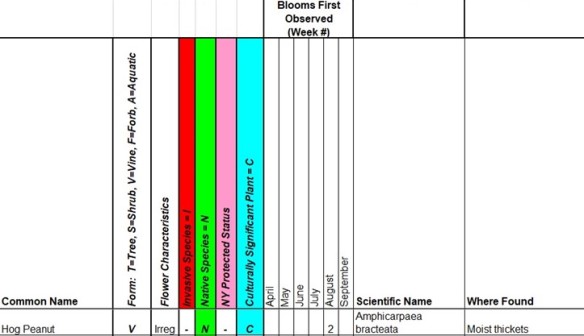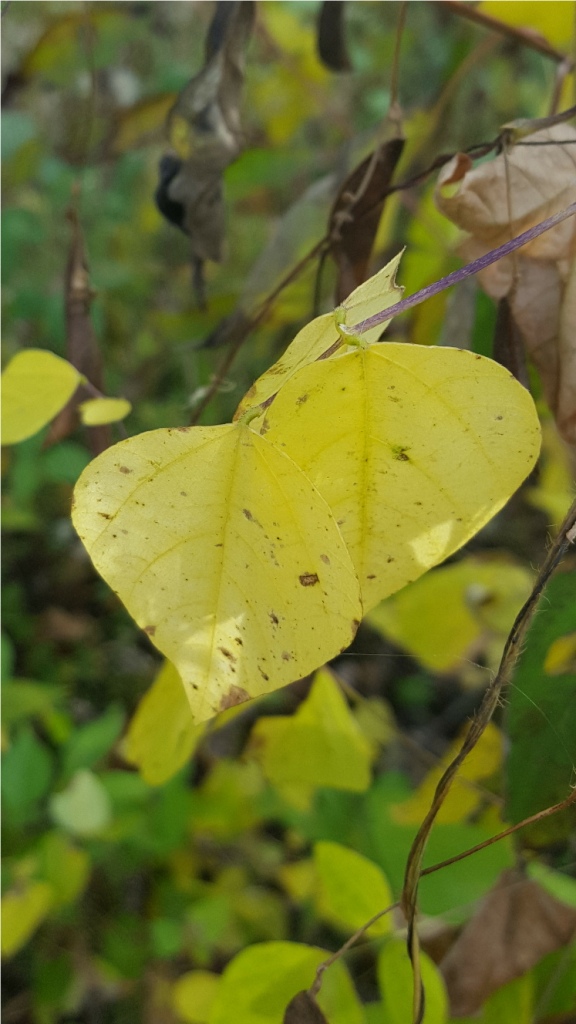This week, I’m featuring Hog Peanut (Amphicarpaea bracteata) as one of our local wildflowers that begins to bloom at this time.

PLEASE NOTE: Culturally Significant Plant = Ethnobotanic Uses: The plant was used by many American Indian tribes of the Plains as a food source. They also used it as a digestive aid. Read more.
Identification Tips:
This native annual twining vine grows up to 8 feet long on slender light green to reddish stems. Tendrils are absent, but the stem twines in a left to right orientation around adjacent vegetation. Alternate trifoliate leaves occur along the stem with the terminal leaflet being the largest and on a much longer stalk than all other leaves on the stem. All leaflets are oval with smooth margins.
Hog Peanut produces two different types of flowers, each of which is located on a different part of the plant. Chasmogamous flowers (those requiring a pollinating agent) appear above ground along the stem and cleistogamous flowers (self-pollinating flowers) appear on low stolons along the ground and often just beneath the soil surface.
Small chasmogamous flowers occur in a cluster consisting of up to fifteen ½-inch long 5-parted tubular flowers. The cluster elongates as the first flowers start to open. The flowers are light pink, pale lavender, or white in color. One petal forms the upright banner (which folds backward), 2 form lateral wings and 2 form a keel, which curves upward between the two laterals. Fertile flowers are replaced by seedpods about 1-1½” long; these seedpods are oblong and flattened with short curved beaks. Each seedpod contains 1-4 relatively large flattened seeds.
Cleistogamous flowers lack petals and do not open. These inconspicuous flowers are produced on low stolons along the ground that search for crevices in the soil; they mature into single-seeded fleshy fruits with a spherical shape that bury themselves just below the soil surface in a manner similar to peanuts.

Credit: E. Small and P.M. Catling. “Poorly Known Economic Plants of Canada – 36. Hog Peanut (Talet Bean), Amphicarpaea bracteata” IN The Canadian Botanical Association Bulletin, February 2003, 36(1): 8-13.
Due to their tendency to drape over vegetation, the trifoliate leaves are easily viewed in their fall color of pale yellow.

Hog Peanut
Folklore:
The Omaha, Winnebago, Ponca and Dakota also shared in the harvests made by field voles they called “bean mice”, who cached as much as several quarts of hog-peanuts in storage pits they excavated near their nests.
Midwestern American Indian tribes such as the Ojibway, Omaha, Pawnee and Sioux, and eastern tribes such as the Delaware collected the fleshy fruits from the stores of mice, rats, moles, and ground squirrels. The Dakota typically replaced the seeds they removed with an equal amount of corn or other food for the rodents. The Dakota Indians have a popular moral tale associated with this plant:
A woman plundered the seed storehouse of a mouse, without leaving anything in return. That night, she had a vision of herself crying in despair that her children were starving, and in a dream a spirit reminded her of the obligation to go back to where she had taken the seeds and leave something in return. But the woman ignored the messages. Shortly after, a great prairie fire consumed her village and the surrounding area, leaving everyone to wander destitute on the prairie, the children crying from hunger.
Culinary and Medicinal Uses:
Hog Peanut produces very nutritious underground seeds, which were once a valuable food for American Indians, especially in the Missouri Valley. Each fleshy seed contains 25% protein, which was the best protein source of any wild plant used by them. They also used the aboveground beans in various ways, cooking them separately or with cornmeal, and to make bean bread.
The underground fruits can be eaten raw or boiled to remove the hulls and the seed eaten like a nut. The tough skin was removed by boiling during which it would crack, or by rubbing after the pod had been soaked in warm water. They are mature in September and October, but retain their vitality throughout the winter, so that they may even be harvested (dug) in the following spring.
North American Indians also used Hog Peanut for a variety of medicinal purposes. The Cherokee Indians applied boiled tea of the underground parts to snake bites and also used the tea to treat diarrhea. The Iroquois used it to treat digestive problems as well as tuberculosis. The Chippewa employed a similar preparation in combination with other species as a laxative.
Wildlife Value:
It is a larval host for Silver-Spotted Skipper (Epargyreus clarus), Northern Cloudywing (Thorybes pylades), Long-tailed Skipper (Urbanus proteus), Gray Hairstreak (Strymon melinus), and Gold-Banded Skipper (Autochton cellus).
Either the seeds in the aboveground seedpods or the fleshy fruits of self-fertile flowers are eaten by Ruffed Grouse, Wild Turkey, Eastern Chipmunk, White-Footed Mouse, and Meadow Vole; the Ruffed Grouse also feeds on the foliage. To a limited extent, White-Tailed Deer also feed on the foliage.
Where Found Locally:

















